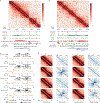Direct DNA crosslinking with CAP-C uncovers transcription-dependent chromatin organization at high resolution
- PMID: 32839564
- PMCID: PMC8274026
- DOI: 10.1038/s41587-020-0643-8
Direct DNA crosslinking with CAP-C uncovers transcription-dependent chromatin organization at high resolution
Abstract
Determining the spatial organization of chromatin in cells mainly relies on crosslinking-based chromosome conformation capture techniques, but resolution and signal-to-noise ratio of these approaches is limited by interference from DNA-bound proteins. Here we introduce chemical-crosslinking assisted proximity capture (CAP-C), a method that uses multifunctional chemical crosslinkers with defined sizes to capture chromatin contacts. CAP-C generates chromatin contact maps at subkilobase (sub-kb) resolution with low background noise. We applied CAP-C to formaldehyde prefixed mouse embryonic stem cells (mESCs) and investigated loop domains (median size of 200 kb) and nonloop domains (median size of 9 kb). Transcription inhibition caused a greater loss of contacts in nonloop domains than loop domains. We uncovered conserved, transcription-state-dependent chromatin compartmentalization at high resolution that is shared from Drosophila to human, and a transcription-initiation-dependent nuclear subcompartment that brings multiple nonloop domains in close proximity. We also showed that CAP-C could be used to detect native chromatin conformation without formaldehyde prefixing.
Conflict of interest statement
Competing interests
C.H. is a scientific founder and a member of the scientific advisory board of Accent Therapeutics, Inc. and a shareholder of Epican Genetech. B.R. is a co-founder and a member of the scienceitific advisory board of Arima Genomics Inc.
Figures






References
-
- Sexton T & Cavalli G The role of chromosome domains in shaping the functional genome. Cell. 160, 1049–1059 (2015). - PubMed
-
- Pombo A & Dillon N Three-dimensional genome architecture: players and mechanisms. Nat. Rev. Mol. Cell Biol 16, 245–257 (2015). - PubMed
-
- Dekker J, Rippe K, Dekker M & Kleckner N Capturing chromosome conformation. Science 295, 1306–1311 (2002). - PubMed
-
- Zhao Z et al. Circular chromosome conformation capture (4C) uncovers extensive networks of epigenetically regulated intra- and interchromosomal interactions. Nat. Genet 38, 1341–1347 (2006). - PubMed
Publication types
MeSH terms
Substances
Grants and funding
LinkOut - more resources
Full Text Sources
Molecular Biology Databases
Miscellaneous

